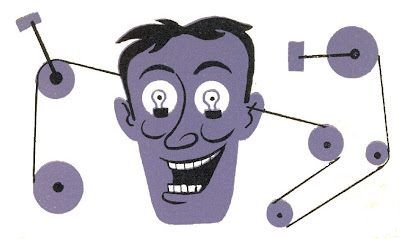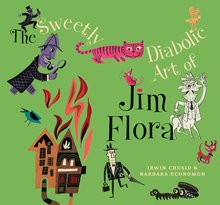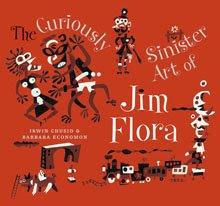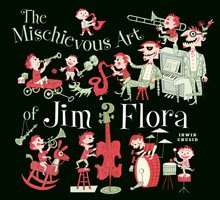 The full title of this undated (early- to mid-1940s) work is The Rape of the Stationmaster's Daughter, a tempera on paper, titled in pencil on the reverse. It was reproduced in our second Flora anthology, The Curiously Sinister Art of Jim Flora, and its anatomically absurd actors were adapted by designer Laura Lindgren for the cover. In 2008 we issued a fine art print.
The full title of this undated (early- to mid-1940s) work is The Rape of the Stationmaster's Daughter, a tempera on paper, titled in pencil on the reverse. It was reproduced in our second Flora anthology, The Curiously Sinister Art of Jim Flora, and its anatomically absurd actors were adapted by designer Laura Lindgren for the cover. In 2008 we issued a fine art print. A customer purchased a print last month and expressed admiration at the quality of both the work and the replica. But truth to tell, our Stationmaster print has not sold well. I suspect the subject matter creeps people out. It's sinister and diabolic—and goes beyond mere mischief. Who wants a cartoonish depiction of a sexual-assault-in-progress adorning the living room?
A customer purchased a print last month and expressed admiration at the quality of both the work and the replica. But truth to tell, our Stationmaster print has not sold well. I suspect the subject matter creeps people out. It's sinister and diabolic—and goes beyond mere mischief. Who wants a cartoonish depiction of a sexual-assault-in-progress adorning the living room?Yet this work will always be special to me. At the time Barbara Economon and I compiled our first book, The Mischievous Art of Jim Flora, in 2004, we had seen very little of Flora's early fine art. He was primarily known for his album covers and commercial music iconography, topical magazine illustrations, and children's books. What fine art of Flora's we had seen consisted mostly of his large, late-period maritime canvases, which did not capture our interest.
 When I was first shown (by Flora's family) his fine art collection in storage on a rainy Saturday in October 2005, one of the first works pulled from a jammed portfolio was Stationmaster. I ogled it with amazement. It was gorgeous, even as it was disturbing. It was a depiction of evil, yet it had a magical quality, transporting me to another world, revealing the deeper Flora artistic vision that had been a family heirloom to that point. I didn't see darkness in the tableau. The aged, pigment-soaked paper evoked the privately creative side of Flora during the 1940s. I never forgot that moment: the birth of an obsession.
When I was first shown (by Flora's family) his fine art collection in storage on a rainy Saturday in October 2005, one of the first works pulled from a jammed portfolio was Stationmaster. I ogled it with amazement. It was gorgeous, even as it was disturbing. It was a depiction of evil, yet it had a magical quality, transporting me to another world, revealing the deeper Flora artistic vision that had been a family heirloom to that point. I didn't see darkness in the tableau. The aged, pigment-soaked paper evoked the privately creative side of Flora during the 1940s. I never forgot that moment: the birth of an obsession.We don't know if the work was based on a historical incident or simply reflects Flora exorcising his demons with a paint brush. Barbara's color-matched print faithfully captures the original, right down to the muddy backwash. You can almost feel the brushstrokes.






















































